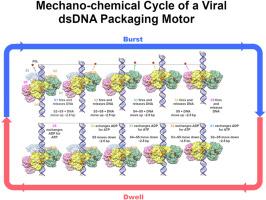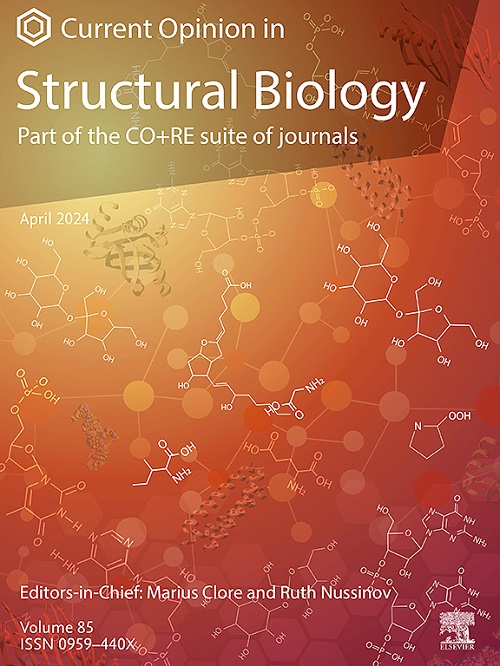病毒基因组包装马达的机械化学原理
IF 6.1
2区 生物学
Q1 BIOCHEMISTRY & MOLECULAR BIOLOGY
引用次数: 0
摘要
双链DNA病毒利用病毒编码的ASCE ATPase环马达产生的能量,积极地将其基因组包装到预先组装好的蛋白囊壳中。二十世纪八十年代和二十一世纪初的单分子实验证明,这些马达是自然界中一些最强大的分子马达,ATPase 环马达周围各个亚基的活动高度协调,以确保高效的基因组封装。虽然这些研究提供了一个全面的动力学方案来描述包装过程中发生的事件,但力的产生和亚基协调的物理基础仍然难以捉摸。本文回顾了最近的结构和计算成果,这些成果已开始阐明这些强大分子马达产生作用力和 DNA 转位的分子基础。本文章由计算机程序翻译,如有差异,请以英文原文为准。

The mechano-chemistry of a viral genome packaging motor
Double-stranded DNA viruses actively package their genomes into pre-assembled protein capsids using energy derived from virus-encoded ASCE ATPase ring motors. Single molecule experiments in the aughts and early 2010s demonstrated that these motors are some of the most powerful molecular motors in nature, and that the activities of individual subunits around the ATPase ring motor are highly coordinated to ensure efficient genome encapsidation. While these studies provided a comprehensive kinetic scheme describing the events that occur during packaging, the physical basis of force generation and subunit coordination remained elusive. This article reviews recent structural and computational results that have begun to illuminate the molecular basis of force generation and DNA translocation in these powerful molecular motors.
求助全文
通过发布文献求助,成功后即可免费获取论文全文。
去求助
来源期刊

Current opinion in structural biology
生物-生化与分子生物学
CiteScore
12.20
自引率
2.90%
发文量
179
审稿时长
6-12 weeks
期刊介绍:
Current Opinion in Structural Biology (COSB) aims to stimulate scientifically grounded, interdisciplinary, multi-scale debate and exchange of ideas. It contains polished, concise and timely reviews and opinions, with particular emphasis on those articles published in the past two years. In addition to describing recent trends, the authors are encouraged to give their subjective opinion of the topics discussed.
In COSB, we help the reader by providing in a systematic manner:
1. The views of experts on current advances in their field in a clear and readable form.
2. Evaluations of the most interesting papers, annotated by experts, from the great wealth of original publications.
[...]
The subject of Structural Biology is divided into twelve themed sections, each of which is reviewed once a year. Each issue contains two sections, and the amount of space devoted to each section is related to its importance.
-Folding and Binding-
Nucleic acids and their protein complexes-
Macromolecular Machines-
Theory and Simulation-
Sequences and Topology-
New constructs and expression of proteins-
Membranes-
Engineering and Design-
Carbohydrate-protein interactions and glycosylation-
Biophysical and molecular biological methods-
Multi-protein assemblies in signalling-
Catalysis and Regulation
 求助内容:
求助内容: 应助结果提醒方式:
应助结果提醒方式:


